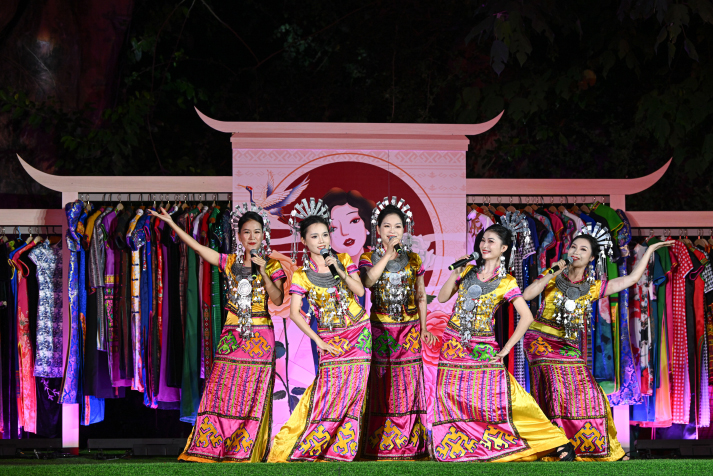| Lifestyle |
| Stories of social evolution—through style | |
|
|
 Elsbeth van Paridon, an editorial consultant with Beijing Review, speaks at a salon during the Eighth China-European Union Literary Festival in Beijing on November 5 (COURTESY PHOTO)
From mid-October to late November each year, the China-European Union (EU) Literary Festival invites a dozen authors from EU member states and China to hold discussions on different topics related to contemporary literature in four major Chinese cities. At a related literature salon at the Zhongshuge Bookstore in Beijing on November 5 as part of the festival's eighth edition, Beijing Review's editorial consultant Elsbeth van Paridon (Dutch) spoke about fashion and how it reflects the social trends of any given time—from the EU to China. The following is an edited excerpt from her speech: Fashion is an art form that encompasses more than just clothing or accessories; it's a reflection of society and a representation of individual identity. From ancient times to the present, fashion has had a rich and varied history, shaped by historical events and cultural influences. It has always reflected cultural identity, providing a means of expressing cultural heritage and traditions through clothing and accessories. Fashion has also reflected social and political change, with many designers using their platforms to advocate for social and political causes. So let's start with Europe. What did fashion mean to people in old Europe? And in the 20th and 21st centuries? What does it tell us about society at a particular time? Fashion has been used to give visual currency to various sociopolitical movements. Much of this talk will focus on women's fashion, but we are going to kick things off with the men. Men who loved their heels. In the 17th and 18th centuries, fashion existed to establish a person's importance. Fashion said a lot about a person's social status and place in society. This helped establish social barriers to behavior, conduct and gender roles. The European elite could easily be distinguished from the crowd by their extravagant, impractical clothing. The working class dressed in practical clothes that allowed them to move around and, well, work. Sounds a lot more comfortable, even if it comes at the cost of a lot of hard work and social stigma. At the Palace of Versailles, King Louis XIV (1638-1715) instituted a strict dress code that required visiting nobles to wear only the latest fashions. To ensure an ever-changing array of clothing options, Louis ordered new fashions be designed every two years, with new textiles—as well as accessories such as parasols, fans, furs and capes—appearing in summer and winter. According to the Fashion History Timeline website, Louis also came up with the idea of advertising each season's new fashions by commissioning the production of fashion plates engraved with French clothing that could be purchased at home and abroad. Soon other countries began to copy Louis, recognizing that the planned obsolescence of upper-class clothing was a good economic stimulus.  A fashion show presents the traditional costumes of local ethnic groups in Wuzhishan, Hainan Province, on October 22 (XINHUA)
Gender roles To maintain feminine beauty and attract men, women were expected to wear corsets and have smaller waists. This made sense because larger breasts, smaller waists and wider hips were associated with sexual attractiveness and fertility. These perceptions had a major impact on fashion, leading to corsets and wide, structured petticoats, restrictive clothing that left little room to move. After all, the social responsibilities expected of women were confined to the home, supervising maids, tutoring and domestic service. "Movement" was not on the agenda. All in all, the history of European fashion has been largely shaped and controlled by gender and social roles. Fast forward 300 years… For women in the 1920s, sartorial freedom reflected the new freedoms they had to pursue careers, to attend college and to enter the professions. Skirt hemlines continued to rise, but perhaps the most revolutionary change took place in hairstyles. Hair had been cut shorter by trendsetters since before World War I (1914-18), and by the 1920s, the chin-length bob had become the style of choice for many women. After the end of World War II (1939-45), much emphasis was placed on dressing the young. Before the war, children and teenagers had basically worn the same clothes as their parents for most of history. After 1945, a complete teen wardrobe emerged. It consisted of clothing that was either extremely tight or baggy. Blue jeans, once scorned as prison garb, were popularized by movies with young, charismatic stars; perhaps the most important example was Rebel Without a Cause (1955), in which James Dean played the jean-clad protagonist. Jeans were rebellious and young. The 1960s were a time of breaking with tradition. Self-expression was encouraged. The decade provided a wealth of style inspiration influenced by the youth of the day. Moving away from the prim and proper 1950s and into a rebellious new era, Swinging Sixties fashion was revolutionary. Key fashion styles of the decade included mod, beatnik and hippie looks, all of which captured the artistic, fun and free spirit of the era. The miniskirt made its debut in the decade and changed women's fashion forever. With its daringly short design, the skirt shocked conservatives by allowing women to show off their legs in defiance of conformity. The 1980s were wild. Yuppie (young urban professionals flashing the cash) culture, big hair and an anything-goes vibe saw many across Europe engage in what we today consider a fashion faux pas—or two. But the funny thing is, fashion has and still goes through a plethora of changes every decade as we can see through the history of European fashion. But most aspects of it are still remembered by designers and vintage enthusiasts alike. Some women have a proclivity for 1920s fashion. Corsets have even made a comeback on catwalks from Milan to Paris in the 2020s. The makeup and hairstyles of some eras are very much sought after. Standing here in Beijing and thinking about the crossroads between Chinese and European fashions... That whole "stepping back in time" does ring a bell, now doesn't it? Hanfu, the traditional dress of the Han Chinese, anyone? The China notes The term Made in China is undergoing the ultimate 21st-century makeover. This rapidly changing landscape is a unique phenomenon that goes beyond the mere summer/winter collections; it waves the flag for the changes vibrating within China's society at large today. Escorted by the increasingly strong influence of a new thinking among China's younger generations regarding individuality and the expression thereof, the fashion scene in the country is exploding. The Made in China label has been redefined. Take, for example, the qipao that made its debut, in its modern form, in 1920s Shanghai. This garment at the time symbolized women's newfound empowerment, their pursuit of education and their quest to set foot in the real world—a far cry from the imperial days when women's bound feet kept them largely indoors. Take, for example, the guochao trend that has taken over wardrobes in the 2020s. Meaning "hip heritage," and packed with traditional Chinese elements, guochao has become the epitome of China's long-lost but now retrieved cultural confidence. Take, for example, the focus many Chinese designers today are placing on sustainability. From fabrics to minority techniques to reviving the country's rural areas by teaming up with, for example, minority weaving or embroidery collectives, these components contribute to a greener, cleaner future. And take, for example, the proclivity for genderless streetwear and sneaker culture. Especially for a Chinese woman, this hip-hop-inspired boss swag has become the ultimate token of empowerment in the 2020s. The pioneering fashion scene in China. It is more than your mere cover shot; it's the visualization of a changing social landscape. Louis would agree. Comments to elsbeth@cicgamericas.com |
|
||||||||||||||||||||||||||||
|